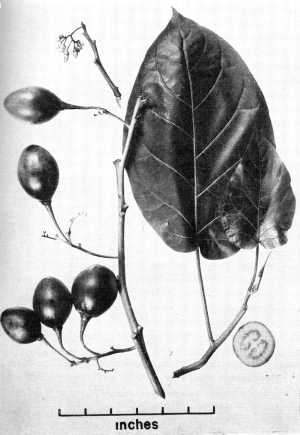Tree Tomato, Tamarillo
Scientific Name: Cyphomandra betacea (Cav.) Sendt.
Synonym: Cyphomandra crassicaulis, Solanum betaceum
Family: Solanaceae
Sunset®: 14-27
USDA: 9b-11
Frost Tolerance: Hardy to 25° F (-4° C)
Sun Exposure: Full sun to light shade
Origin: Andes mountain of Peru
Growth Habits: Shrubby tree 10 to 12 feet high (3 to 3.5 m) or more
Watering Needs: Regular water, does better with moist, well drained soil
Propagation: Seeds, cuttings
The Tree Tomato is generally considered a native of Peru and performs best at medium to high elevations. It is more popular in the Asiatic Tropics, New Zealand, and the Andean region of South America than in the Caribbean region. It forms a shrubby tree 10 to 12 feet high (3 to 3.5 m); occasional plants reach a height of 20 or 25 feet (6 to 7.5 m) and have a trunk diameter of about 4 inches (10 cm). The large cordate-ovate leaves are soft-pubescent and are 3 to 12 inches long (7 to 30 cm).
Blooming Habits:
The small, pinkish, fragrant flowers are produced in April or May in short axillary cymes near the ends of the branches.
Fruiting Habits:
The mature fruits resemble a hen's egg in size and shape and, in the West Indies, ripen from October to January. The 2-carpeled fruits are orange, red, or purple, depending on the variety. Internally the fruit consists of a meaty mesocarp and tomatolike seeds imbedded in a watery pulp. In flavor it is subacid and is generally considered to resemble the garden tomato (Lycopersicon esculentum Mill.). The fruit may be cut and eaten raw but is most commonly stewed to form a conserve. It can also be made into jam or preserves. Unlike the garden tomato, the seeds and skin of the tree tomato should be removed before cooking.
Culture:
It is shallow-rooted, susceptible to nematodes and requires rich, moist, well-drained soil. Heavy mulching is recommended to protect the easily damaged roots. The seedlings grow rapidly and generally produce the second year.
Desert-Tropicals is dedicated to provide gardening advice, gardening ideas, and information about flower of all kind for landscape and collections.We try to check carefully the identification of the plants on the illustrations as well as the other information from the page, but occasionally errors do occur. if you notice anything that needs to be changed please contact us.Thanks.
© 1998-2020 Philippe Faucon, All Rights Reserved.
